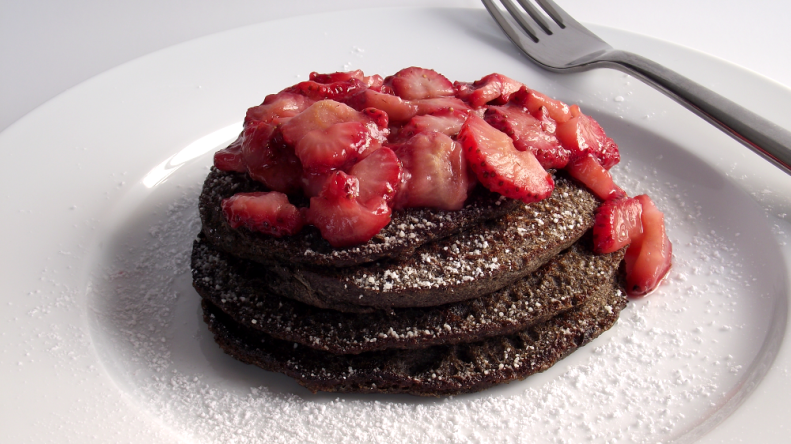So, let’s say you’re a ridiculously ambitious cook who had recently cooked a large meal based exclusively on a single country’s cuisine. And you have leftovers spilling from your fridge. And, if the leftovers were all Mexican, the last thing you want to put in your mouth is more Mexican food, no matter how tasty it is.
Today’s impromptu cooking project started with a simple snack:

This is what I came up with after five minutes of raiding the pantry, surveying the fridge, microwaving, stirring, chopping, and rinsing. Meet Punjabi papad masala. Try saying that three times fast! On second thought, maybe not- I don’t want anyone to hurt themself. The bottom layer is Punjabi papadum crisps, purchased raw from the ethnic grocer, then lightly sprayed with oil and microwaved until crispy. The greens are watercress, stemmed and thoroughly rinsed. Campiri tomatoes were roughly chopped. The sauce/dressing is some leftover Greek yogurt into which I stirred some honey and fresh-squeezed Meyer lemon juice (can you tell the produce situation in Alaska is improving greatly?).
After crunchy-munching away, with eyes watering slightly from the hefty kick of the Punjabi spice and the watercress’ inherent pepperiness, I returned to the kitchen and dejectedly gazed at the leftover yogurt-honey-lemon mixture.
Something tingled deep in my head.
I opened the fridge to once again inventory the selection of ageing Mexican goodies. The tingle grew to a vibration. I glanced from the adobo-marinated roast pork, to the salsa, to the rice pilaf, then sneaked a peek back to the yogurt mixture. The ingredients listing for everything did some sort of voodoo in my brain, then the figurative light bulb came on.
What other cuisine shares the same ingredients as the rice pilaf? Cilantro, onion, celery? Chinese!
And what about the salsa: tomato, onion, garlic, chiles, cilantro? I’ll take Indian for $1,000, Alec.
So the rice pilaf was sauteed up with some of the pork (chopped), frozen mixed veggies, ground dried coriander, Chinese 5-spice, fried egg, and soy sauce to make this delicacy:

Fried rice, yay!
So what if I took the Mexican salsa from the other night (pictured here simmering in the pan):

Threw it in the food processor, added the remaining leftover yogurt sauce, sprinkled in some cumin, garam masala, curry powder, dumped in some more of the leftover chopped pork, and stirred in a healthy splash of cream. Pork tikka masala!

Ah, but why stop there? Bet ya can’t guess what this is, even though all of the ingredients are either pictured or the soon-to-be-added components have already been mentioned in this post:
 Not sure? I don’t blame ya, so here’s another hint: it’s an obscure dish common among the Maori people of New Zealand. Still scratching your head? No worries. The above photo is the beginning phase of making a proper Maori boil-up (pork bone, watercress, sweet potato, dumplings). Embarassingly, I didn’t realize the pork roast was bone-in, but was tickled pink when I was carving it up for the other repurposing efforts and discovered a huge honking slab of bone, with all kinds of meaty bits still attached. Into a small pot of water it went; it simmered and boiled, covered, for a half hour before I lifted the lid and allowed it to reduce by half, then turned off the heat. Tomorrow’s boil-up lunch should be terrific!
Not sure? I don’t blame ya, so here’s another hint: it’s an obscure dish common among the Maori people of New Zealand. Still scratching your head? No worries. The above photo is the beginning phase of making a proper Maori boil-up (pork bone, watercress, sweet potato, dumplings). Embarassingly, I didn’t realize the pork roast was bone-in, but was tickled pink when I was carving it up for the other repurposing efforts and discovered a huge honking slab of bone, with all kinds of meaty bits still attached. Into a small pot of water it went; it simmered and boiled, covered, for a half hour before I lifted the lid and allowed it to reduce by half, then turned off the heat. Tomorrow’s boil-up lunch should be terrific!
Who knew that international cuisine could be so easily converted to trademark dishes from other countries! Next month’s themed dinner is Italian, but I can’t fathom how I’m going to give those leftovers a globetrotting makeover.
 Ingredients: buckwheat flour, potato starch, buttermilk, baking powder, baking soda, salt, brown sugar, vanilla extract, cinnamon, allspice, egg. Compote: strawberries, honey, water.
Ingredients: buckwheat flour, potato starch, buttermilk, baking powder, baking soda, salt, brown sugar, vanilla extract, cinnamon, allspice, egg. Compote: strawberries, honey, water.









 Not sure? I don’t blame ya, so here’s another hint: it’s an obscure dish common among the Maori people of New Zealand. Still scratching your head? No worries. The above photo is the beginning phase of making a
Not sure? I don’t blame ya, so here’s another hint: it’s an obscure dish common among the Maori people of New Zealand. Still scratching your head? No worries. The above photo is the beginning phase of making a  (Everything pictured is gluten-free.)
(Everything pictured is gluten-free.)